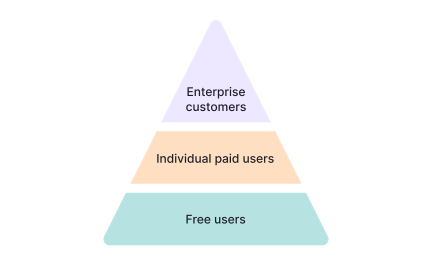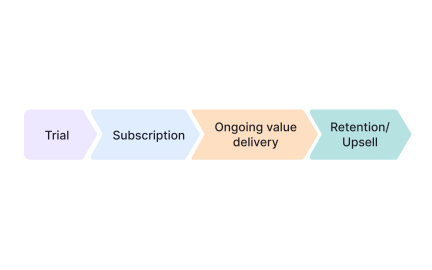Monthly Recurring Revenue (MRR)
Monthly recurring revenue (MRR) measures the predictable income from subscriptions each month, helping teams forecast and track growth.
What is Monthly Recurring Revenue?
Your business struggles with unpredictable cash flow because revenue comes in sporadic chunks from one-time sales, making planning impossible and growth unsustainable when you can't predict next month's income or invest confidently in growth.
Most companies focus on individual transaction values without building recurring revenue streams, missing the transformative power of subscription models that create predictable Monthly Recurring Revenue (MRR) enabling confident investment and sustainable growth.
Monthly Recurring Revenue (MRR) is the predictable revenue a business can expect every month from subscription customers, calculated by multiplying the number of paying customers by average revenue per account, providing the key metric for subscription business health.
Companies optimizing for MRR achieve 78% more predictable growth, secure 50% higher valuations, and build significantly more sustainable businesses because recurring revenue creates compound growth rather than starting from zero each month.
Think about how Salesforce built a empire on MRR while competitors sold one-time licenses, or how Netflix's subscription model enabled massive content investments impossible with transactional video rental revenue.
Why Monthly Recurring Revenue Matters for Business Success
Your business feels like a hamster wheel because without recurring revenue, every month starts at zero, requiring constant new sales just to maintain position while subscription competitors build compounding revenue that funds innovation and growth.
The cost of lacking MRR compounds through every growth constraint and planning challenge. You can't invest confidently, struggle with cash flow, lose to subscription competitors, and eventually face existential crisis when customer acquisition costs exceed one-time purchase values.
What effective MRR strategies deliver:
Better business predictability and planning because recurring revenue provides visibility into future cash flows rather than hoping next month matches last month.
When companies build strong MRR, growth becomes plannable rather than praying for good months to offset bad ones without predictability.
Enhanced company valuation and fundability through revenue quality that investors value at higher multiples rather than transactional revenue's uncertainty.
Improved customer relationships and lifetime value because subscriptions create ongoing relationships rather than transactional interactions without continuing engagement.
Stronger competitive moats as high MRR creates switching costs and customer lock-in rather than competing for every transaction.
Accelerated growth through compound effects where retained revenue funds acquisition rather than replacing churned revenue just to stay flat.
Advanced Monthly Recurring Revenue Measurement and Optimization Approaches
Once you've established basic MRR, implement sophisticated growth and optimization approaches.
Cohort-Based MRR Analysis: Track MRR by customer cohorts rather than aggregates, revealing which segments drive sustainable growth versus churn risks.
Multi-Product MRR Expansion: Build product suites that increase account values rather than single subscriptions, maximizing MRR per customer.
Usage-Based MRR Models: Implement pricing that grows with customer success rather than fixed subscriptions, aligning value with revenue growth.
MRR-Focused Organization Design: Align teams and incentives around MRR growth rather than one-time sales, ensuring organizational focus on recurring value.
Step 1: Analyze Current Revenue for Recurring Potential (Week 1)
Identify which products or services could shift to subscription model rather than assuming everything must stay transactional, finding MRR opportunities within existing business.
This creates MRR foundation based on current strengths rather than completely new business models that require starting from scratch.
Step 2: Design Compelling Subscription Offers (Week 2-3)
Create subscription packages that provide ongoing value rather than forced recurring billing, ensuring customers want to maintain subscriptions rather than feeling trapped.
Focus value proposition on continuous benefit rather than just payment convenience, building subscriptions customers value not just tolerate.
Step 3: Build Retention and Expansion Systems (Week 3-4)
Develop customer success processes that reduce churn and increase account values rather than just acquiring new MRR, recognizing retention drives sustainable growth.
Balance acquisition with retention investment to ensure MRR grows through both new customers and expanding existing accounts.
Step 4: Implement MRR Tracking and Analytics (Week 4-5)
Create dashboards tracking new, expansion, contraction, and churned MRR rather than just total, understanding component movements that drive overall trends.
Step 5: Optimize Pricing and Packaging for MRR Growth (Month 2+)
Test pricing strategies that maximize long-term MRR rather than initial purchase, potentially accepting lower entry prices for higher lifetime values.
This ensures MRR strategies drive sustainable growth rather than short-term revenue at expense of long-term value.
If MRR initiatives don't improve predictability, examine whether subscriptions provide genuine ongoing value rather than forced recurring billing.
The Problem: High churn rates that erode MRR gains, requiring constant new sales just to maintain revenue levels rather than grow.
The Fix: Invest in retention before acquisition rather than growth at all costs, ensuring MRR compounds rather than replacing churned revenue.
The Problem: Subscription models that don't provide ongoing value, leading to customer resentment and churn when they question monthly charges.
The Fix: Design for continuous value delivery rather than access fees, ensuring customers gladly pay for ongoing benefits not just past implementation.
The Problem: Cannibalizing existing revenue when shifting to subscriptions, causing short-term pain that tests organizational resolve.
The Fix: Model transition carefully with realistic timeline rather than overnight switch, managing cash flow while building sustainable MRR base.
Create Monthly Recurring Revenue approaches that build sustainable businesses rather than forced subscriptions without genuine recurring value.
Recommended resources
Courses

Product Discovery

Product Analytics








